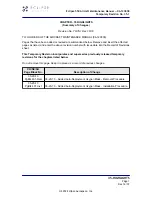
2.2 PRE-LAUNCH
Select an area of the launch that allows room to fully lay out and inflate the glider, AND,
if necessary, to abort your launch after a full inflation.
Lay out your glider perpendicular to the direction of the wind, on its top surface, with the cell openings facing away from the wind.
Pull the wing tips into a slight “arc“ or horseshoe. This ensures that the centre of the glider inflates first and will help the glider inflate evenly and
in a controlled manner. After you have laid out your glider and done a pre-flight inspection, double-check your safety equipment:
➧
Is your helmet on and strap done up?
➧
Ensure that ALL harness straps are properly closed and secured (double-check your leg straps).
➧
Are the ‘A’ lines free, and the rest untangled?
➧
Before launching, establish in you mind your flight path after launch, and the location of the nearest landing zone.
2.3 LAUNCHING
For a forward (or “alpine“) launch, face forward grasping the A-risers in each hand with the other risers arrayed along your forearms (grasp BOTH A-risers on wings equipped with split A-risers). Ensure that you
are centred to the middle of the wing, with equal pressure on both risers. Move forward, accelerating, leaning into the harness chest-strap and pushing upwards on the A-risers in a smooth arc from behind at
approximately waist level, upwards next (and close to) your head. The effort required on the A-risers and on the run will depend on the wind-strength. In a strong wind, less effort will be required and it may even be
necessary to apply a little brake to prevent the wing from moving too far forward.
A launch with a winch is exactly the same. Follow the instructions of the winch operator.
2.4 FLIGHT
2.4.1 Turning
The ATIS is a very agile glider. This is a design feature favoured by experienced pilots. If you are new to DHV 1–2 gliders, or new to Sky Paragliders line of exceptionally agile paragliders, exercise care with control inputs until you
have familiarized yourself with the superb handling of this wing. It is easy to enter a turn by leaning in the direction of the turn, and applying some brake in the same direction. As with all aircraft, the sink rate will increase in
a turn, and increases more with steeper turns. Turns can be made throughout the normal speed range (speeds without the speed system engaged). However, turning at very low flying speed can lead to a full stall
(section 2.6.4), while high speed turns can lead to a spiral dive (section 2.5.4).
When the speed system is in use, turns should only be minor course adjustments accomplished with small movements of the brakes or, a gentle lean in the
turn direction.






































